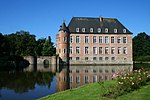De Viron Castle
De Viron Castle (Dutch: Kasteel de Viron; French: Château de Viron) is a castle in Dilbeek, Flemish Brabant, Belgium. It has served as the town hall of Dilbeek and offices of the municipality since 1923 and was listed as a protected monument in 1990.[1]
History
The castle was built in 1863 by Jean-Pierre Cluysenaar, and commissioned by the de Viron family, which settled in Dilbeek in 1775. It was built in Renaissance Revival style on the ruins of a 14th-century fortification which was destroyed in 1862. One of the medieval towers, the Sint-Alenatoren, can still be seen in the park surrounding the current building. It is named after Saint Alena, who lived in Dilbeek.[1] It became the town hall of Dilbeek in 1923, and was protected as a monument in 1990.
Architecture
The castle counts 12 towers, 52 rooms, 365 windows and 7 staircases. This refers to the Julian Calendar which has 12 months, 52 weeks, 365 days and 7 days in a week. The castle lies in a park, with several other buildings of interest: a farm, an ice cellar and a coach house.[2]
References
- ^ a b "Gemeentewebsite Dilbeek: Dilbeek". www.dilbeek.be. Archived from the original on 31 October 2004.
- ^ "Toerisme Dilbeek - Zien". Archived from the original on 2012-04-25. Retrieved 2011-10-10.
External links

- Official website
- v
- t
- e
- Dilbeek
- Groot-Bijgaarden
- Schepdaal
- Itterbeek
- Sint-Martens-Bodegem
- Sint-Ulriks-Kapelle

- Sint-Anna-Pede
- Sint-Gertrudis-Pede
- Groot-Bijgaarden Castle
- Watermill Sint-Gertrudis-Pede
- De Viron Castle
- Sint-Anna Church
















